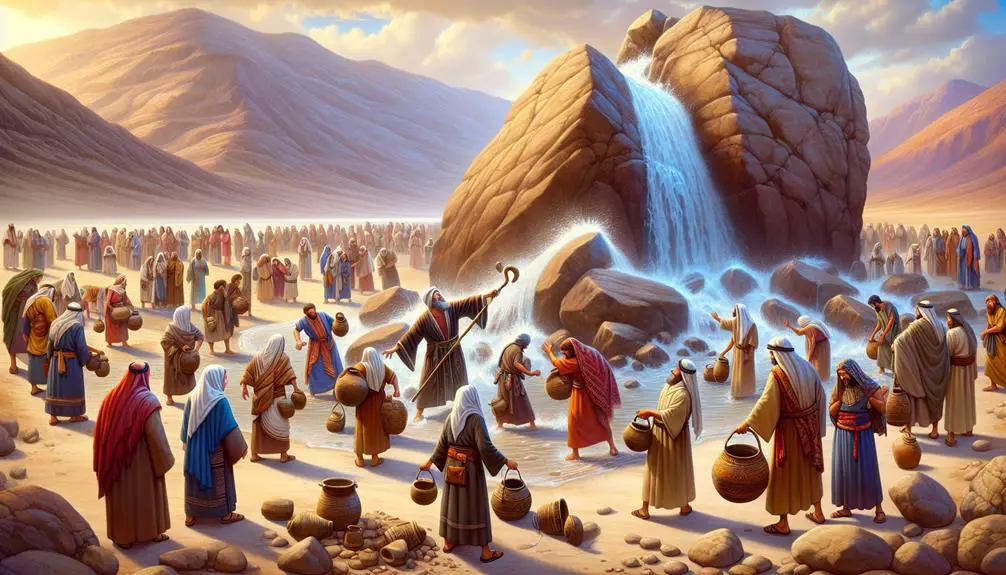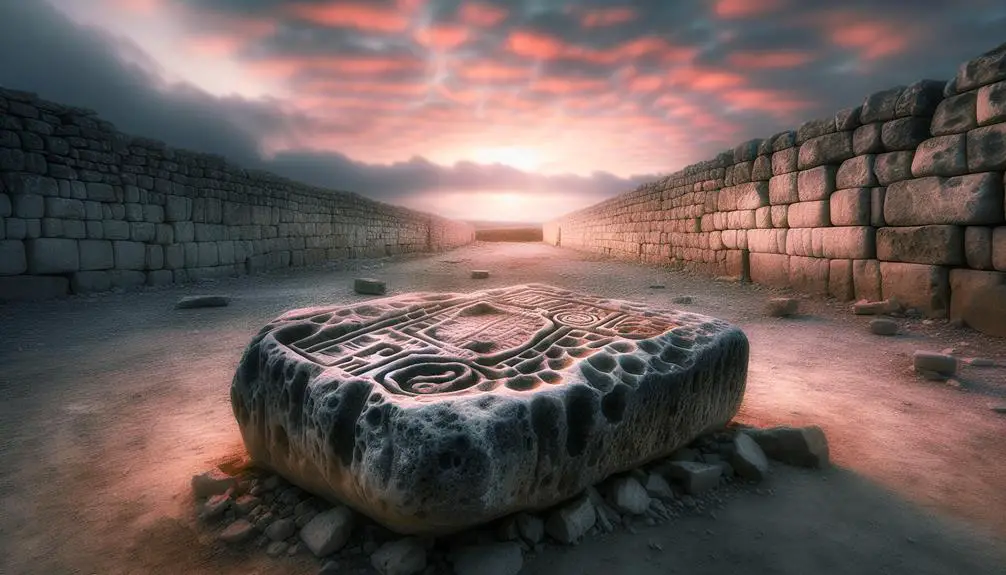From Moses' water source to David's Goliath defeat, discover how rocks in the Bible shape faith and destiny.

Rocks in the Bible
The significance of rocks in biblical texts cannot be understated; their symbolic presence weaves through narratives, shaping spiritual and physical landscapes alike. From Moses striking the water rock to David's strategic use of five stones against Goliath, these elements are not mere backdrop but pivotal to understanding the interplay between divine intervention and human action.
Further contemplation on the builders' rejected stone and the use of rocks as altars and memorials reveals layers of meaning that transcend their physicality. As we explore these instances, the question arises: what deeper insights can we uncover about faith, resilience, and the foundation of spiritual belief?
Key Takeaways
- Rocks symbolize divine permanence, judgment, and the foundational nature of spiritual laws.
- Biblical narratives use rocks to illustrate faith, divine provision, and the importance of divine encounters.
- Stones serve as physical reminders of God's covenant, embodying the unchanging and sacred relationship between God and His people.
- Rocks in the Bible highlight the intersection of divine intervention and human action, emphasizing faith and obedience.
The Symbolism of Stones

In biblical literature, stones often serve as multifaceted symbols, embodying concepts of permanence, divine judgment, and spiritual foundation, as evidenced by various scholarly interpretations and scriptural references. The stone tablets of the Ten Commandments, for instance, are emblematic of the unchanging and eternal nature of God's law, underscoring the concept of permanence (Exodus 24:12). These tablets, hewn from stone, signify not only the durability of the divine decrees they bear but also the steadfast relationship between God and His people.
Moreover, precious gems in the Bible frequently symbolize the inherent value and beauty of wisdom and virtue. In Proverbs 3:15, wisdom is described as 'more precious than rubies,' suggesting an intrinsic worth that surpasses even the most esteemed material possessions. This analogy highlights the enduring significance of spiritual wealth over temporal riches.
Additionally, stones in scriptural narrative often reflect divine judgment. The act of stoning, prescribed in the Old Testament for certain transgressions, symbolizes the ultimate consequence of sin, reinforcing the gravity of disobedience to divine law (Deuteronomy 22:24). This practice, though stark, serves as a narrative and legal mechanism through which the concept of justice is communicated.
The symbolic use of stones thus weaves a complex tapestry of meanings throughout biblical texts, from the foundational stone tablets of the covenant to the precious gems representing wisdom's value. This imagery enriches the scriptural narrative, offering layers of interpretation that underscore the multifaceted relationship between the divine and the human, the eternal and the temporal.
Moses and the Water Rock

Building upon the intricate symbolism of stones within biblical literature, the narrative of Moses striking the rock to bring forth water (Exodus 17:6) offers a profound exploration of faith, divine provision, and the consequences of disobedience. This episode, occurring within the broader context of the Israelites' desert wanderings, underscores the critical theme of miraculous provision essential for desert survival. The rock, typically emblematic of harsh, lifeless environments, transforms into a source of life-sustaining water, illustrating a divine reversal of natural expectations.
Scholars such as Durham (1987) have suggested that this event not only signifies God's capacity to provide but also acts as a theological motif underscoring the necessity of obedience and trust in divine commands. The act of Moses striking the rock, as commanded by God, can be seen as an act of faith, a physical demonstration of trust in God's promise to provide for His people in the most inhospitable of circumstances.
However, this narrative also foreshadows future consequences of disobedience. Numbers 20:12 highlights a similar incident where Moses' actions, contrary to God's instructions, result in a denial of entry into the Promised Land. This juxtaposition serves as a powerful reminder of the covenantal relationship between God and His people, where faith and obedience are rewarded, and disobedience carries profound repercussions.
David's Victory With Five Stones

Among the most celebrated narratives of biblical heroism, David's victory over Goliath, armed with nothing but five smooth stones and unwavering faith, stands as a testament to divine support and the power of belief (1 Samuel 17). This story transcends its historical and religious context, offering insights into the underpinning themes of faith, determination, and divine intervention within the biblical tradition. The choice of a simple sling and stones by David, a young shepherd, against the Philistine giant Goliath, illustrates a profound reliance not on physical might but on spiritual strength and precision.
- The selection of five smooth stones represents a deeper symbolic faith in providence over sheer force. Each stone, meticulously chosen from a stream, signifies preparation guided by divine foresight.
- Goliath's downfall was not merely a result of David's physical act but is widely interpreted as the culmination of divine will acting through human agency. This event highlights the biblical motif of God empowering the seemingly weak to confound the mighty.
- The accuracy of the sling, a skill David honed as a shepherd, underscores the biblical value of diligence and mastery over one's craft. David's sling accuracy, pivotal for Goliath's downfall, symbolizes the intersection of divine provision and human skill.
In analyzing David's victory, it becomes apparent that the narrative is structured around the themes of faith, divine assistance, and the efficacy of combining spiritual belief with honed skill. The story serves as a powerful reminder of the potential for divine intervention in human affairs, especially when faith is coupled with preparedness and skill.
The Builders' Rejected Stone

Turning our attention to the metaphor of 'The Builders' Rejected Stone,' as recounted in Psalm 118:22 and further echoed in the New Testament, we explore its profound implications for understanding divine selection and rejection within biblical narratives. This passage metaphorically speaks to the cornerstone's significance in construction, symbolizing the indispensable and foundational role of an element initially deemed unworthy by human judgment. The architectural metaphor serves as a critical lens through which to view the paradox of divine choice, where what is dismissed by human standards is often exalted by God.
In the context of biblical theology, the cornerstone represents Jesus Christ, who, despite being rejected by the leaders of His time, becomes the pivotal foundation of the Church (Acts 4:11, 1 Peter 2:7). This interpretation not only highlights the cornerstone's significance in the spiritual edifice but also challenges prevailing notions of worthiness and authority. The narrative insists on a divine architecture where God's selection often defies human expectations and societal norms.
Scholars have noted that this metaphor extends beyond a single event, encapsulating a broader theme of reversal found throughout the biblical text. The 'rejected stone' motif invites believers to reconsider their understanding of value and purpose, emphasizing that God's choices are sovereign and often unconventional. By integrating this architectural metaphor, the biblical authors convey a powerful message about rejection and acceptance, foundation and fulfillment, challenging readers to reflect on the dynamics of divine selection and human recognition.
Rocks as Altars and Memorials

Throughout biblical history, rocks have served not only as natural elements of the Earth but also as significant symbols, utilized for creating altars and memorials that mark divine encounters and covenantal moments. These tangible elements have consistently been pivotal in the expression of faith and remembrance in the Judeo-Christian tradition, embodying both the permanence and sanctity of their associated events.
The significance of rocks as altars and memorials in the Bible can be encapsulated in three pivotal instances:
- Stone tablets: The quintessential representation of God's covenant with His people, the stone tablets of the Ten Commandments, underscore the use of rocks not merely as physical objects but as bearers of divine law and testament (Exodus 31:18).
- Jacob's pillow: A rock served as Jacob's pillow during his dream of the ladder reaching to heaven. This stone was later set up as a pillar, a memorial of the place where God spoke to him, signifying a sacred encounter (Genesis 28:11-22).
- Altars of remembrance: Throughout the Old Testament, altars built from uncut stones were erected by individuals such as Noah, Abraham, Isaac, Jacob, and Moses as memorials of God's promises or interventions. These altars were not for aesthetic appeal but were symbolic of unmediated, raw encounters with the divine, emphasizing the direct and unrefined relationship between God and humanity (Genesis 8:20, 12:7, 26:25).
These instances highlight how rocks, in their most unadulterated form, have been integral in commemorating divine fidelity and human responses to it. Their enduring nature reflects the everlasting covenants they represent, anchoring spiritual heritage in the physical realm.
Frequently Asked Questions
How Do Geological Studies of the Holy Land Contribute to Our Understanding of Biblical Events Involving Rocks?
Geological studies in the Holy Land offer invaluable insights into biblical narratives, particularly those entailing rocks. By examining rock symbolism within these contexts, researchers can uncover layers of meaning previously obscured.
Furthermore, geological timelines serve as a vital tool, enabling scholars to anchor biblical events in a specific historical framework. This interdisciplinary approach not only enriches our understanding of sacred texts but also bridges the gap between science and spirituality.
In the Context of Biblical Narratives, How Did Ancient Civilizations Source and Transport Large Stones for Construction?
In the study of ancient civilizations' sourcing and transporting large stones for construction, it is evident that stone quarries played a crucial role. Ancient engineering techniques facilitated the extraction and movement of these materials over considerable distances.
Are There Any Specific Rocks or Stones Mentioned in the Bible That Have Been Conclusively Identified or Located by Archaeologists?
In the realm of archaeological and mineralogical studies, the quest to identify specific rocks or stones cited within ancient texts poses a complex challenge. Such endeavors, blending scientific rigor with historical inquiry, have made strides in correlating biblical references with tangible findings.
Through rock symbolism analysis and precise mineralogical examination, scholars have endeavored to locate and authenticate several biblically mentioned stones, although definitive identification often remains elusive due to the passage of millennia and geographical changes.
How Do Different Translations of the Bible Handle the Terminology for Rocks and Stones, and Does This Affect the Interpretation of Certain Passages?
Different translations of religious texts often vary in their terminology, including terms for rocks and stones, which can significantly influence interpretation and understanding.
This variation underscores the importance of translation accuracy and an awareness of cultural interpretations. Scholars argue that discrepancies in these terms among translations might alter the perceived significance or symbolic meaning in certain passages, highlighting the intricate relationship between linguistic choices and theological or historical insights.
What Role Do Rocks and Stones Play in the Rituals and Religious Practices of Other Cultures Mentioned in the Bible?
In the tapestry of global religious practices, stones and rocks often emerge as potent symbols, transcending mere physicality to embody divine or spiritual presence.
Stone worship practices, observed across various cultures, signify a reverence for the earth and its elements, embedding rocks with ritual symbolism.
Analytically, these practices reveal a universal inclination towards venerating natural objects, suggesting an intrinsic human need to connect with the terrestrial through sacred rites and ceremonies.
Conclusion
In conclusion, the symbolic representation of rocks and stones within biblical narratives serves not only as a foundation for theological imagery but also as a cornerstone for understanding the multifaceted relationship between the divine and the mundane.
Through the narratives of Moses, David, and the use of rocks as altars and memorials, the biblical text illustrates the profound significance of these natural elements in the spiritual and historical consciousness of the people.
The analysis of these stories, enriched by the technique of parallelism, underscores the enduring legacy of rocks as both literal and metaphorical pillars of faith.



Sign up